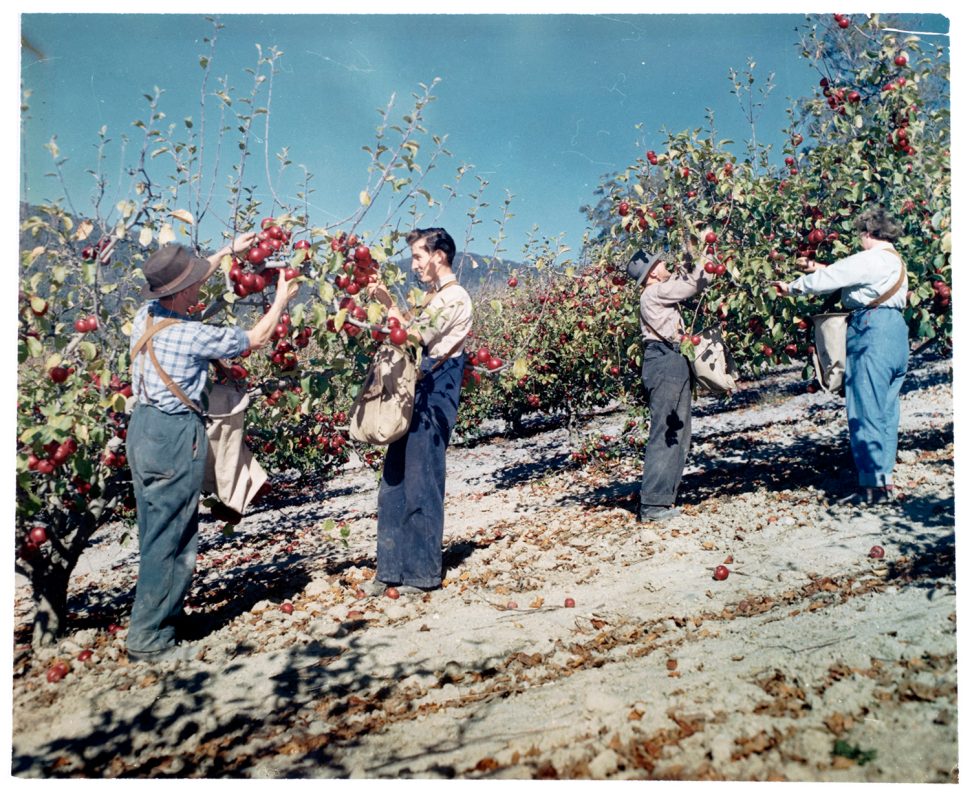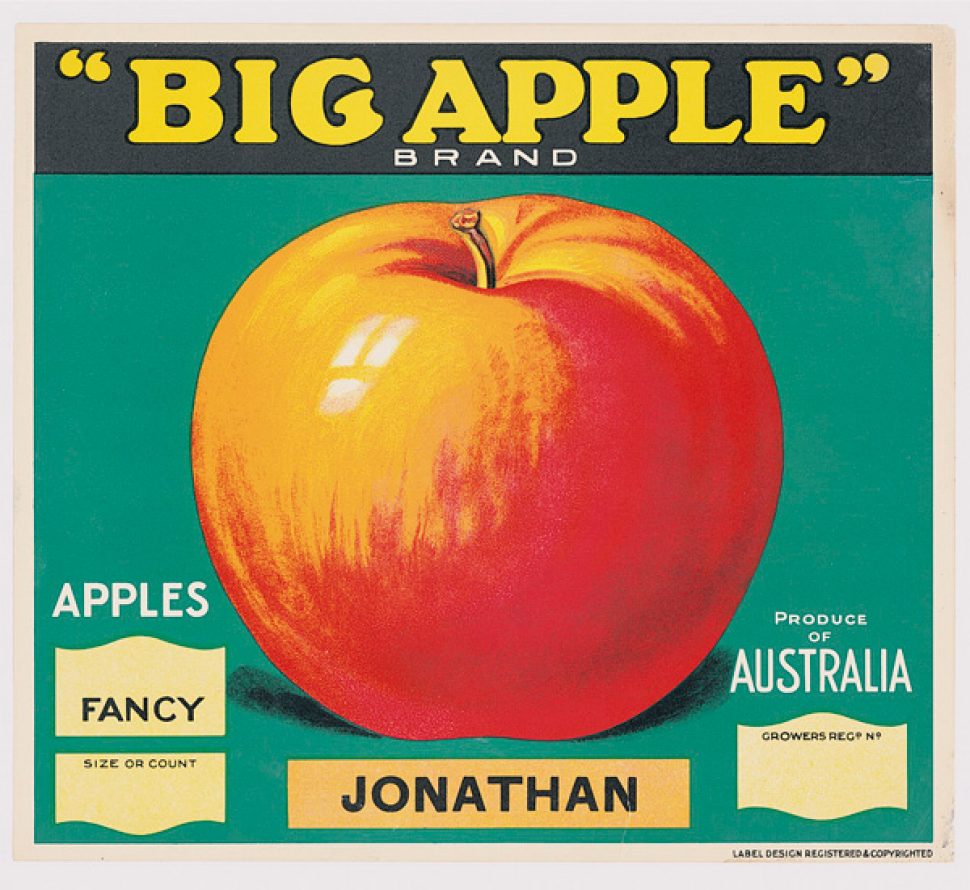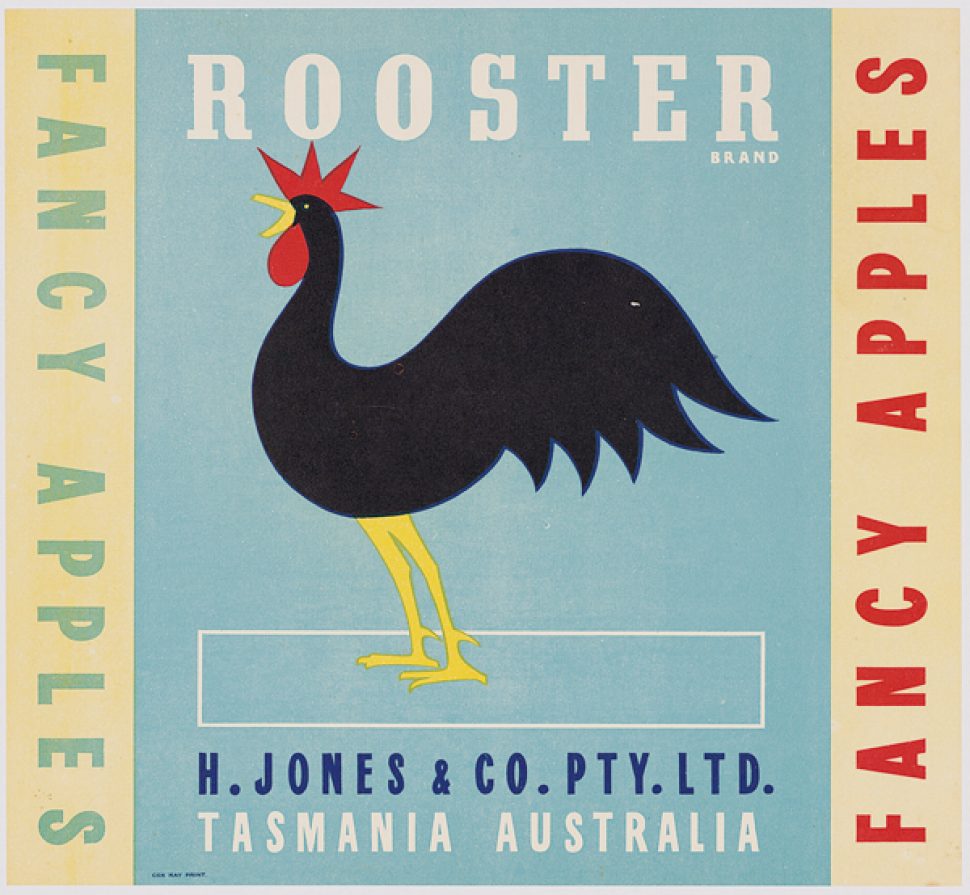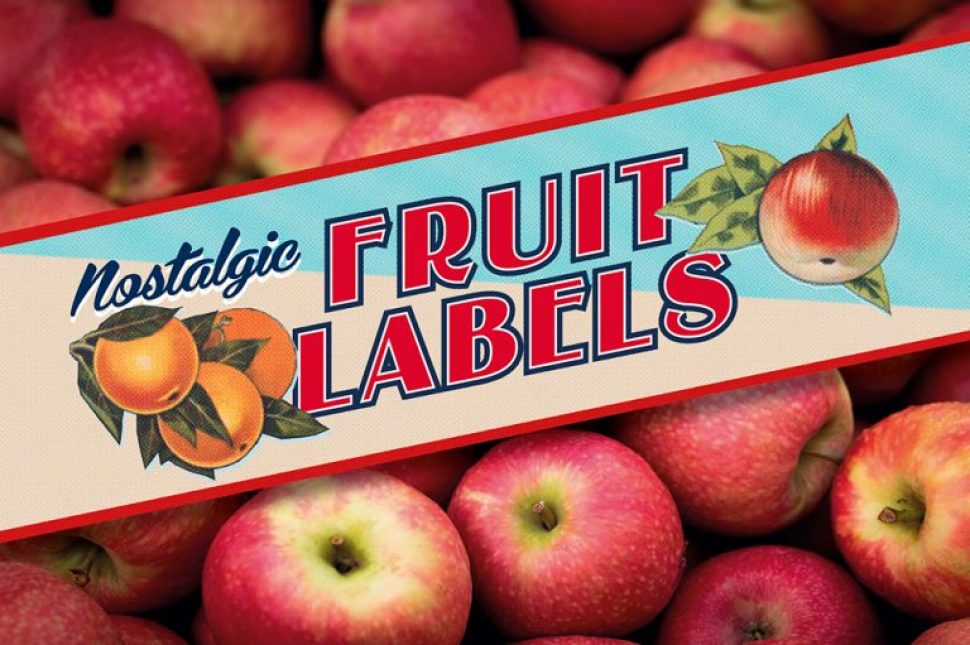The 2016 Nostalgic Fruit Labels stamp issue, released on 7 June 2016, conjures up a bygone era of advertising, design and marketing. The paper labels pasted on to the ends of wooden fruit boxes, between the 1920s and 1970s, are a widely collected form of ephemera and provide a window into the fruit production and export industries of the time.
Christopher Cowles and David Walker were consultants to Jane Levin, the researcher on the stamp issue.
As well as providing invaluable and encyclopaedic advice, the two are authors of an award-winning book on Australian apple labels, which provided vital information on the background of the apple labels featured, as well on labels more generally.
The Art of Apple Branding: Australian apple case labels and the industry since 1788 (Apples from Oz) not only delves into the history of the apple-growing industry in Australia, but also explores the role apple labels played in the advertising and marketing.
The book also discusses how the labels were designed and printed. At the end of the book is a full index of every known apple label, complete with historical details around the grower, designer, brand and more. It truly is a treasure-trove of information – the result of over a decade of research, which included interviews with growers and designers of the era.
What began with the intention of producing a book about Tasmanian apple labels, based in part on a final year group essay by David and three fellow Fine Art and Design students studying at the Tasmanian School of Art, grew to encompass all of Australia and became a nationally significant publication.
As David explains:
In 1986 the collector Ray Harrison contacted the Tasmanian School of Art as a result of his receiving a letter from a collector friend in the United States of America (telling him about a student essay on Southern Tasmanian apple labels) …
As a result Ray contacted the Art School and spoke with Chris about his collection of Tasmanian fruit labels. This was the catalyst for Chris to contact each of the four now ex-students to gauge their interest in picking up the project and potentially taking it further to a more thorough study and producing a publication. David was the only one to agree.
Over the next fifteen years we researched, on a part time basis, public and private collections nationally and internationally. It involved much letter writing-before the use of emails, oral history interviews and when we could afford it some trips interstate to interview artists, growers and view collections. We attended two Ephemera Society of Australia conferences, which enabled us to enter the world of the collector and make some worthwhile connections with collectors and academics studying this area.
Although Ray’s collection was listed in the National Library of Australia’s Australian Historic Records Register of 1988, through our research we contributed another 44% of rare and unique labels to his collection.
In 2006, the book won a National Print Award Silver Medal for Chris’ book design and for the print overseer, Rod Poole. In 2007 it was shortlisted for both The Tasmania Book Prize and The University of Tasmania Prize for a Book Published in Tasmania. It won the latter award.
Collectable ephemera from the “Apple Isle”
Both David and Christopher are Tasmanian, so they grew up understanding the size and importance of the apple industry. David recalls coming home from school in the 1960s seeing the cargo ships waiting out on the River Derwent for a berth in Hobart so they could load their cargo of apples for export.
This was very much a part of the day-to-day goings on around the port areas throughout Tasmania. And Christopher recalls spring-time trips to the Huon Valley to view the apple blossom and seeing lines of trucks weaving through Hobart streets during the height of picking season, on route to wharves in Sullivan’s Cove.
And Christopher actually designed fruit labels himself, during the 1960s and 1970s:
“As a graphic designer, they were regarded as ‘bread and butter’ jobs when I designed labels back in the 1960s and again in the mid-1970s. The ‘design’ was often pre-determined by the orchardist, exporter or print buyer before the professional ‘commercial artist/designer’ prepared the artwork … Artists were mainly ‘the skilled wrist’ used to bring about the finished artwork,” Christopher says.
When asked why fruit labels are admired and collected, Christopher says, “They have a particular charm not evident in the computerised design and printing technology of today… They are relatively small, colourful and inexpensive at the moment as well as being suitable for framing to hang on the wall.”
“Like any ephemera by its very nature it is here today-gone tomorrow … The fruit labels provide a vibrant, informative slice of Australian social and business life. During the research for the book we coined the term, ‘industrial folk art’ as a way of expressing how we believe they represent the combination of the industrial process for which they were used, as well as how they were produced and the naïve character of much label design,” says David.
“After the introduction of printed cartons, the piles of labels were chopped up and put by the telephone for scrap paper or given to the children to use as drawing paper. Now people are intrigued by the past and value the handmade and craft of various old printing technologies. The labels are not being reproduced anymore so have vanished, once this happens the rare becomes sought after. Many families have told us that they didn’t even keep a copy of their label!” adds David.
The marketing of Australian fruit
While the labels are fun, bright and highly collectable, as a marketing tool they didn’t necessarily live up to expectations. The very fact that there were thousands of individual ‘brands’ and labels actually had a negative impact overall, despite the pride and fondness the Australian industry had for them.
As Christopher explains:
“Australian fruit marketing has a chequered history. Mixed and unclear messages were conveyed to buyers … (and) … every Australian state behaved as if they were in direct competition, hence there wasn’t any coherent marketing or branded message. Had David and I been living in New Zealand the book would not have happened. New Zealand marketing is regarded as being very effective as they branded and marketed their apple industry under one label.”
The author's favourites
So which labels are David’s and Christopher’s favourite?
For David, it’s “The “Big Apple” Brand from Victoria, the quintessential apple label. I love its simplicity, the use and intensity of the colour and the texture on the apple.”
For Christopher: “If I were to pick a favourite it would be the Rooster Label ‘designed’ by my friend, Max Angus, who is over 100 and continues to paint his favourite subject and something close to my heart, the ‘real’ Lake Pedder, which was inundated for a hydro-electric power scheme in 1972. It was one of the few more daring designs and was based on, as Max says, the way Matisse used design and colour.”
The labels featured in the Nostalgic Fruit Labels stamp issue are from the Troedel Printing Archive in the State Library Victoria as well as the Pickering Brook Heritage Collection.
The Pickering Brook Heritage Group, and others, also provided valuable information and images for the Nostalgic Fruit Labels prestige book. The prestige book discusses the history and production of labels, and those associated with them, including interesting anecdotes and colourful photographs.
David and Christopher also note that while surviving labels are relatively rare overall, there are collections within the State Library of Tasmania (now known as LINC), Hobart; The Queen Victoria Museum and Art Gallery, Launceston; The Stanthorpe and District Historical Society and Museum; The Beaconsfield Mine & Heritage Centre; IP Australia; and small collections in local history societies.
David Walker has worked as a professional photographer and librarian for over thirty years. His photography has won awards and been exhibited nationally and internationally. He works in Reprographic Services at the Tasmanian Archives and Heritage Office.
During the 20 years at the University’s Tasmanian School of Art, Christopher Cowles was the Studio Head of Graphic Design. Presently a freelance artist, he is involved in community based arts projects and is currently a member of the local Council’s Arts and Culture and Streetscape Committees.
The Nostalgic Fruit Labels stamp issue is available from 7 June 2016 online, at participating Post Offices and via mail order on 1800 331 794, while stocks last.
This article was produced at the time of publication and will not be updated.





